New Testament Times
Christ's Birth - Was Jesus born in a stable?
|
|
No room in the inn...and she laid Him
in a manger. Away in a manger, but not a stable? We
know the Christmas story so well. Mary and Joseph traveled from Nazareth
to Bethlehem and were turned away from the village inn by the innkeeper.
They took refuge in a barn, where baby Jesus was born and laid in a
manger. A very early church tradition says the site of the nativity was
a cave near Bethlehem. For God so loved the world, that He gave His only begotten Son, that
whosoever believeth in Him should not perish, but have everlasting life
(John 3:16). |
Christ's Boat on the Sea of Galilee - Did Jesus really sit on this boat discovered in the Sea of Galilee?
|
|
Late in January 1986, between the
ancient harbors of Gennesar and Magdala, local residents made the chance
discovery of a boat's oval outline in the muddy lake bed. Word spread
like wildfire. In less than two weeks, local newspapers were announcing
discovery of "the Jesus boat." Did Jesus really perform
miracles from this boat (Mark 4:39)?
Marathon round-the-clock excavations
ensued, racing against both now-rising waters of the Sea of Galilee and
treasure seekers. The archaeologists even invented new techniques of
excavation and preservation as they went along. Just before the site was
flooded, the almost completely intact hull was fully excavated, encased
in polyurethane and floated to shore for further study and conservation.
But did Jesus really walk on water along side this boat (Matthew 14:25)?
The boat is 26 1/2 feet long, 7 1/2
feet wide and 4 1/2 feet high. It was probably of the Sea of Galilee's
largest class of ships. Fore and aft sections were most likely decked
and it probably had a mast, meaning it could be both sailed and rowed.
Did Peter, James and John actually row this boat (John 6:19)? Evidence of repeated repairs
suggested the boat had a long life. But, in the end all usable wooden
parts were evidently removed and the remaining hull sunk to the lake
bottom. This is what archaeologists recovered. Could this be the boat
abandoned by the disciples when they followed Jesus (Luke 5:11)? Studies
of ancient ships suggest this vessel had a crew of five (four rowers and
a helmsman). The ancient Jewish historian Josephus referred to such
ships holding 15 people. Skeletal remains from Galilee during this
period indicate males averaged 5 feet 5 inches tall [1.651 meters] and
about 140 pounds [63.503 kilograms]. Fifteen such men could fit into
this vessel. So did Jesus and the Twelve sail together in this boat? The Galilee boat dated to the general
time of Jesus' ministry. It was the type used by Jesus and the Twelve,
and was large enough to hold 13 men. It may have been in use at the same
time He sailed the sea. He may have even seen it. BUT, there is no proof
that this boat was ever actually used by Jesus or any of the disciples. Archaeologists, as scientists, should
not make spectacular claims about their finds. Thus, Jesus cannot be
connected to this particular boat with certainty. Yet, it helps us
visualize daily life in Galilee as Jesus knew it. This is archaeology's
contribution to illuminating Scripture. REFERENCES |
The Cross - On what kind of a cross was Jesus crucified?

Pictured are three types of crosses commonly used by the Roman army in the
first century A.D. Each carried an inscription stating the victim's capital
offense and a seat-like projection, not designed for the victim's comfort, but
to prolong their agony. Nails and ropes held the victim's legs and arms in
place.
The cross on the left was called a "high tau" cross because
it was shaped like the capital Greek letter tau ("T"). The
middle cross was known as a "low tau" cross, shaped like the
lower case tau ("t"). In both cases the central post was
generally set permanently in the ground while the cross bar was carried to the
site by the victim. The cross on the right was an actual tree still in the
ground (dead or alive) with its limbs serving as the cross bar. Jesus was
probably crucified on a "low tau" type cross.
"For
what I received I passed on to you as of first importance; that Christ died for
our sins according to the Scriptures, that He was buried, that He was raised on
the third day according to the Scriptures." (I
Cor. 15:3-4)
The Cross - Why do all four Gospels contain different versions of the inscription?
|
|
THE
INSCRIPTIONS Let us begin with the way each writer
prefaces the inscription(s).
Notice that all
these prefaces differ. Mark tells us that a superscription was written;
Matthew, that it was set up over his head; Luke, that it was written in
three languages; and John, that Pilate was the writer. All these
statements are correct, even though each writer says something
different! The four accounts of the inscription
are arranged below so the similarities and differences are easily
discerned: |
|
|
|
What
was the significance of using three languages? It was the custom of the Romans to
use gypsum letters written on a rough board affixed to a cross to
proclaim the reason why a person was being executed, although three
languages were not always used. Latin was the official language of the Roman Empire; it represented human
government, power, and conquest. Greek was the international
language of culture; it represented human wisdom, art, and commerce. Hebrew
was the religious language of the Jews; it represented the Covenant
Race, the Law of God, and the means by which God made Himself known to
man. In the providence of God, all of these human and divine
institutions were addressed when Jesus was crucified. How did this come
about? The most probable scenario is that
the Roman governor, Pilate, dictated the title in Latin and the
centurion in charge of the execution implemented the edict and its
translation into the other languages. The words 'King of the Jews' were
a public sneer at the Jews by Pilate, and this was compounded by his
additional taunt that their 'king' came from Nazareth, i.e. that he was
a despised Galilean. JOHN As John is the only Gospel writer who
mentions Pilate, or Nazareth, or who calls the inscription a 'title'
(Latin titulus), it is abundantly evident that John is quoting
the Latin which read:
(Latin used 'I' and 'V' where English
uses 'J' and 'U'.) That this is the Latin is further confirmed by the
fact that the Early Church adopted as a symbol the Latin letters 'INRI',
which are the first letters of this inscription (only), and this symbol
appears in many early paintings of the crucifixion. LUKE Luke was a highly educated man (a
physician- Colossians 4:14) and he addressed his Gospel to a Greek
nobleman (the 'most excellent Theophilus' of Luke 1:3). It is therefore
very reasonable to suppose that Luke gives us the Greek
inscription: OUTOS
ESTIN O BASILEUS TWN IOUDAIWN MATTHEW Matthew wrote for the Jews and used
many quotations from the Old Testament to show that Jesus was the
fulfillment of Old Testament prophecies concerning the Messiah. It is
therefore most likely that Matthew quotes the Hebrew inscription
(see drawing below). MARK This leaves Mark, whose Gospel is
shorter than the other three, and who gives us a somewhat abbreviated
account of the life of Jesus, as his purpose is to tell us more about
what Jesus did than what Jesus said. For example, he omits the birth of
Jesus, as well as the whole of the sermon on the mount and several other
discourses. True to his style, Mark abbreviates the inscription to the
words common to the three languages used, namely 'THE KING OF THE JEWS'.
THE
BOARD Now comes the most interesting part!
The Latin title, being the official indictment, would undoubtedly have
been written first on the board. This then would have determined the
length of the board and/or the size of the letters required to fit the
inscription into one line and for it still to be readable by the crowd
from a distance (John 19:20). In those days they did not use spaces
between the words in any of the languages as we do now, and so John's
Latin 'title' contained just 26 letters and no spaces. Luke's Greek 'superscription'
contained 30 letters, and so must have been written in slightly smaller
letters than was the Latin. It is easy to see that there would not have
been room for 16 more letters for the words 'Jesus of Nazareth' (i.e.
'Jesus the Nazarene') in Greek. Matthew's 'accusation' in Hebrew
contained just 19 letters, which is rather fewer than the two other
languages, because the Jews did not write vowels in Hebrew. Whoever
translated the title into Hebrew apparently did not think it worth
adding 'of Nazareth'. Perhaps he thought that to have lived in Nazareth
was not an indictable offense! If we put all of this together, it is
highly probable that the board with the inscriptions looked as shown
below, with the Latin written first, probably at the top, and then
either the Greek or the Hebrew.
Endnotes Although ancient Hebrew was
dissimilar to the modern typewritten Hebrew script used here for
convenience, the number of letters was the same. |
INRI - What do these letters appearing on the crucifix mean?
|
|
The letters "INRI" are initials for the Latin title that
Pontius Pilate had written over the head of Jesus Christ on the cross
(John 19:19). Latin was the official language of the Roman Empire. The words were "Iesus Nazarenvs
Rex Ivdaeorvm." Latin uses "I" instead of the English
"J", and "V" instead of "U" (i.e., Jesus
Nazarenus Rex Judaeorum). The English translation is "Jesus of
Nazareth, the King of the Jews."
The Early Church adopted the first
letters of each word of this inscription "INRI" as a symbol.
Throughout the centuries INRI has appeared in many paintings of the
crucifixion. By the way, Pilate's title for Christ
was actually written in three languages. And Pilate wrote a title, and put it on the cross.
And the writing was, JESUS OF NAZARETH THE KING OF THE JEWS. This title
then read many of the Jews: for the place where Jesus was crucified was
nigh to the city: and it was written in Hebrew, and Greek, and Latin.
Then said the chief priests of the Jews to Pilate, "Write not, 'The
King of the Jews;' but that he said, 'I am King of the Jews'."
Pilate answered, "What I have written I have written." |
Paul's Cyprus Travels - What has archaeology revealed?
INTRODUCTION
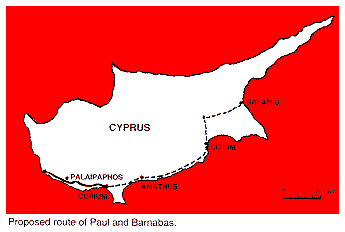
Paul and Barnabas
arrived at Salamis on Cyprus by sea and preceded "through the whole island
as far as Paphos" (Acts 13:6). On other parts of their travels it seems
likely that they took advantage of the network of roads constructed under the
authority of Rome. Thus after leaving Cyprus on their way to Psidian Antioch,
Paul used the via Sebaste constructed in 6 BC by Augustus (e.g., French 1994:
49-58; see also Mitchell 1993: 70).<1> In Macedonia the via
Egnatia served as the route from Neapolis westwards (Gill 1994: 409-10).<2>
The Cyprus journey would have taken the pair of them from the east coast of
Cyprus to the west. This claim may reflect the way that the route used passed
through some of the most important cities of the island. However it is first
important to understand the development of the province.
The province was acquired in 58 BC (Badian 1965), although Cyprus had earlier
been considered as one of the "friends and allies of Rome."<3>
Initially it formed an annex to the Roman province of Cilicia,<4>
and in 48/7 BC the island was returned to the control of Egypt. The death of
Cleopatra in 31 BC brought Cyprus back under Roman control. Subsequently, in 22
BC, Augustus made Cyprus one of the senatorial provinces under a proconsul of
praetorian status. There were no Roman colonies established on the island.
THE ROADS OF ROMAN CYPRUS
The evidence for a road between Salamis and Paphos is twofold; firstly in the
form of the Roman itineraries, and secondly in the form of milestones. The
"Peutinger Table" which lists the routes and mileages would suggest
two possible routes from Salamis (Miller 1916: 827-29). The first cut to the
north-west to Chytri, over the Kyrenia Ridge to the north coast. It then
followed the coast to Soli, Arsinoe (Marion), and then south to Paphos. The
second headed for Citium on the south coast, then westwards to Amathus, Curium
and then Paphos. These routes are not contemporary, and are likely to have
developed over a period of time. The distances can be tabulated as follows:
|
Salamis to Tremithus |
18 |
This gives a total of 115
miles.<5> The alternate route via the north coast would have
been much longer. 88 miles from Salamis to Soli (or 71 miles via Tremithus), and
then another 54 miles to Paphos via Arsinoe, giving a total of 142 miles.<6>
The distances between cities would also be convenient for a day's travel, making
this at least a six day journey from one end of the island to the other.<7>
The best way of dating these roads is by the surviving milestones which often
bear the names of the emperor (Mitford 1980: 1333-35, n. 213). Most of these
belong to the fourth century AD, and are likely to represent a period of repair
to the road system rather than its expansion. Paul's and Barnabas' journey, at
least along the south coast, would have been facilitated by the construction of
a Roman road during Augustus' reign. This is attested by a milestone, located 11
(Roman) miles from Paphos towards Curium (Mitford 1966:98-99 no. 3).<8>
It reads:
[imp.ca]ESAR
AVG[vstvs]
[divif.]PONTIF[ex max.]
[trib.potest.-cos.-]
As
Augustus is named as pontifex maximus the work must have taken place after 12
BC.<9> Although the inscription only allows certainty about the
construction of the road between Paphos and Curium, it is possible that it was
extended eastwards as far as Salamis. The next significant development was the
construction of "new roads" ([via]s novas; Corpus inscriptionum
latinarum III.6732)<10> throughout the province<11>
between July and September 81 during the reign of Titus.<12> A
milestone identified a new road heading north-east from Salamis to Agios
Theodoros and thence presumably to Carpasia.<13> The other
roads which were constructed in the Flavian period were presumably an extension
to the Augustan scheme. Mitford proposed that the route across the heart of
Cyprus from Soli to Salamis was one of these constructions (1980: 1336).
The next main series of inscriptions comes from the Severan period.<14>
As some of these were found along the road heading from Paphos to Curium it is
clear that this was in part repair work. However it is from this period that
there is the first clear indication of a road from Soli to Arsinoe and then
south to Paphos.<15> Given this evidence the simplest solution
to the proposed route of Paul and Barnabas was from Salamis along the south
coast.
THE CITIES VISITED BY PAUL AND BARNABAS
The only cities on Cyprus mentioned in the Book of Acts are Salamis and Paphos.
However if Paul and Barnabas travelled on foot along the Augustan road along the
south coast,<16> they would have passed through Citium, Amathus
and Curium before reaching Paphos.<17>
Three of the cities had been granted the status of asylum in AD 22 due to the
standing of their civic sanctuaries.<18> These were Salamis
(Olympian Zeus; Mitford 1990: 2189-90), Amathus (Aphrodite; Mitford 1990: 2185),
and Paphos (Paphian Aphrodite). It should be noted that although these deities
may sound like anthropomorphic Olympian gods, in fact some had a more regional
feel. Paphian Aphrodite was in fact represented by a sacred rock or baetyl
rather than the cult statue of a goddess.<19> A similar cult of
sacred rocks is recorded near Amathus. An inscription found at Agios Tychon near
Amathus records a cult of "Cyprian Aphrodite" and the sanctuary of
"the Seven within the Stelai" (Mitford 1980: 1302, no. 28; 1946:
40-42, no. 16).<20> The dedication was made by the Roman
governor of Cyprus, L. Bruttius Maximus (79/80). This was presumably a sanctuary
with a central baetyl with other sacred rocks around it. The worship of sacred
rocks is not uncommon in the east. In particular the famous baetyl of Emaesa was
to be taken to Rome by Elagabalus<21> or the cult of Artemis at
Perge (Butcher 1988: 90, fig. 6.114).
The sanctuary of Paphian Aphrodite also came to be linked to the imperial cult.
The imperial cult was linked to the sanctuary of Aphrodite at Palaipaphos. For
example Livia was identified as the new Aphrodite (Gardner, Hogarth and James
1888: 242, no. 61), and Augustus' daughter Julia as Augusta (Inscriptiones
Graecae ad Res Romanas Pertinentes III.940). Other inscriptions relating to the
imperial cult include and honorific inscription for Amyntor son Lysias,
"high priest for life for the well-being of the imperial household" (Mitford
1990: 2197).
|
|
|
Both Salamis and Paphos were the two most important cities on the island. Paphos was the seat of the provincial administration (Mitford 1980: 1309-15), and it was here that Paul met the governor of the island, Sergius Paulus.<22> It had been founded around 312 BC, to replace Palaipaphos. During the second century BC it seems to have become the leading city of the island, taking the prominence away from Salamis.<23> |
The city had been wrecked by an earthquake in 15 BC and Augustus had
subsequently conferred on the city the title Augusta (Mitford 1980: 1310, with
details of the proper title). Further honors were given to the city, perhaps
under Nero, when it received the extra title of Claudia (Mitford 1980: 1310).<24>
Paphos' centrality in the Roman scheme of affairs is also emphasized by the
milestones that mark distances from it. Of the other cities Citium managed to
retain elements of its earlier Phoenician past (Mitford 1980: 1318-20). The
earlier Phoenician cult of Eshmun became that of Asclepius which was active
under Augustus (Mitford 1980:1319). One of the first century BC or Augustan
high-priests and benefactors of the cult carried a name, Asclepiodorus son of
Asclepiodorus, which reveals his links with Asclepius.<25>
Elsewhere in the city a stoa was dedicated in 41 BC to Zeus Keraunios, to the
Divine Julius and to Aphrodite (Corpus Inscriptionum Graecarum 2641; Mitford
1990: 2195). Amathus also had an important cult site of Hera, which was
certainly active in the Claudian period (Inscriptiones Graecae ad Res Romanas
Pertinentes III.974).<26> An altar dedicated to Augustus was
found on the acropolis (Inscriptiones Graecae ad Res Romanas Pertinentes
III.973). The sanctuary of Apollo Hylates, which lay just to the west of the
city, may have been developed at the same time.
In conclusion, the route followed by Paul and Barnabas through Cyprus would have
brought them to several of the key cities of the island, including the three
which had been granted the special status of asylum. The itinerary suggests that
this would have taken at least a week. The road would have brought them into
contact with some of the main cult centers such as the sanctuary of Aphrodite at
Palaipapos. It also led them to the heart of the Roman administration of the
island at Paphos.
NOTES
REFERENCES
Does the New Testament provide a reliable history of Christ's life?
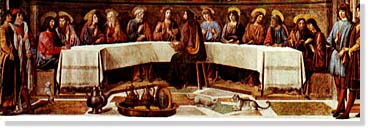
Since it is from
the New Testament that we gain our primary knowledge of Jesus, it is fitting to
ask whether this literature is sound and historically accurate. Critics often
describe the Gospels as pious legend, having no historical competence, and
designed only for propaganda purposes. But while it is acknowledged that the
Gospels are not biography in the strict sense according to 20th century
definitions,[1] the following facts give immense weight to the historical
accuracy of the New Testament.
OBJECTIVE SCHOLARSHIP UPHOLDS THE NEW TESTAMENT
Archaeologists studying ancient civilizations
by uncovering ruins and examining artifacts, are with increasing success
confirming the accuracy of the Biblical texts. Sir William Ramsey's vindication
of Luke's writings is a classic example.[2] The findings of archaeology have in
fact reversed the opinions of a number of former skeptics. Among these is the
scholar Dr. William F. Albright, who writes:
"The
excessive skepticism shown toward the Bible [by certain schools of thought] has
been progressively discredited. Discovery after discovery has established the
accuracy of numerous details."[3]
Recent archaeological
discoveries include both the Pool of Bethesda (John 5:1f) and "The
Pavement" (John 19:13). Their existence was doubted just a few decades ago.
Confirmation of the accuracy of the setting of Jacob's well has also been found
(John 4).[4] Such findings have caused many scholars to reverse earlier
skeptical opinions on the historicity of the Fourth Gospel. Its author has
demonstrated an obvious intimate knowledge of the Jerusalem of Jesus' time, just
as we would expect from the Apostle John. Such detail would not have been
accessible to a writer of a later generation, since Jerusalem was demolished
under Titus' Roman army in 70 A.D.
Also, the recent recovery of a Roman census
similar to the one in Luke 2:1f, and the historical confirmation of his
"synchronism"[5] in Luke 3:1f, underscores the care Luke took in
writing his Gospel (Luke 1:1-4).
Critics of Luke's Gospel often retreat into
non-verifiable and subjective opinions, but they have not overthrown Luke's
historical confirmations.[6] By extension, the other two "Synoptic"[7]
Gospels of Matthew and Mark, painting essentially similar portraits of Jesus'
ministry, are also trustworthy accounts of his life.
Additionally, outside the Bible, Jesus is
also mentioned by his near-contemporaries. Extra-Biblical and secular writers
(many hostile) point to Jesus' existence, including the Roman writings of
Tacitus, Seutonius, Thallus and Pliny, and the Jewish writings of Josephus and
the Talmud. Gary Habermas has cited a total of 39 ancient extra-Biblical
sources, including 17 non-Christian, that witness from outside the New Testament
to over 100 details of Jesus' life, death, and resurrection.[8]
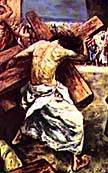 THE
GOSPELS BEAR INTERNAL MARKS OF HISTORICAL INTEGRITY
THE
GOSPELS BEAR INTERNAL MARKS OF HISTORICAL INTEGRITY
There are also characteristics within the
texts themselves which mark the four Gospels as sober history and neither legend
nor fictional propaganda. Consider that the Gospel writers set the leading
disciples in very poor light (Matthew 14:30, Mark 9:33f, Luke 22:54f). Notice as
well that they included hard words by Jesus, which in fact repelled many hearers
(Matthew 21:28f, Luke 9:23f, John 8:39f).
One distinction of the four Gospels is that
their famed treasure of good news lies not nakedly on the surface, but hidden
behind both challenge (Mark 8:34f, John 12:25f)[9] and threat (Matthew 25:31f).
Such characteristics would have been counter-productive to propagandists. Their
presence in the Gospels demonstrates the willingness of the evangelists to tell
the truth, however embarrassing or inconvenient.
THE TEXT OF THE NEW TESTAMENT IS FIRMLY ESTABLISHED
Some express concern that the Bible may have
been altered down through the centuries. It is to this matter that Textual
Critics address themselves. They have discovered entire manuscripts and parts of
others, one portion dating to the beginning of the 2nd Century. The New
Testament has far better textual support than do the works of Plato, Aristotle,
Herodotus, or Tacitus,[10] whose contents no one seriously questions. In
addition, the New Testament documents have always been both public, and
widely-disseminated. Thus it would be impossible for any party to have
materially changed their contents, just as the Declaration of Independence, for
example, as a public document, could not have been privately altered without
raising notice and creating public furor. Sir Frederic Kenyon, former Director
of the British Museum, comments:
"The
interval between the dates of the original composition and the earliest extant
evidence [i.e. our oldest
manuscripts] becomes so small as to be negligible, and the last foundation
for any doubt that the scriptures have come down to us substantially as they
were written has now been removed."[11]
In conclusion, it is not necessary that the
New Testament be treated with "kid gloves" and backed up by special
pleading. Simply allow it to be subject to the very same historical-critical
standards that Classical historians
REFERENCES AND
FOOTNOTES
How do we know that Jesus Christ really rose from the dead?
The most
powerful sign of all that Jesus is who he claims to be, namely the Son of God,
is his resurrection from the dead (Romans 1:4). This is a question with huge
implications: Did it happen? Is the Resurrection story the great exception to
the "usual dreary end of human life?"
Many now consider the
Resurrection to be one of the most sure and certain events of history. A
critical debate on the question "Did Jesus rise from the dead?" took
place recently between world-renowned atheistic philosopher, Dr. Anthony Flew,
and New Testament scholar and Christian, Dr. Gary Habermas. A panel of five
philosophers from leading universities judged the outcome. What was the
conclusion? Four votes for Habermas. None for Flew.[1] And one draw. Flew was
judged to have retreated into philosophical sophistry while evading the
widely-acknowledged historical facts cited by Dr. Habermas.
TWELVE
WIDELY-ACKNOWLEDGED HISTORICAL FACTS
These facts (per Habermas) include:[2]
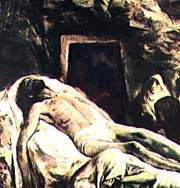 Jesus
died due to the rigors of crucifixion.
Jesus
died due to the rigors of crucifixion. So momentous was this
single event in the First Century that its effects have been described as a "widening
circle of ripples" from a "boulder crashing into the pool of
history."[3] In one of the oddest turns in history, a message centering
on a dead "criminal" (1 Corinthians 1:23) came to be proclaimed as
"good news." Equally amazing was the extent of the Empire-wide
transformation following its proclamation. The impetus for this message was the
conviction that the same Jesus who was crucified was now alive again. These
facts are admitted even by knowledgeable skeptics.[4]
The Resurrection story of course has had its
critics, even from the very beginning. From the account of the first guards in
Matthew 28:11f, all the way to the present, there have been efforts to explain
away his resurrection. Each new attempt, however, is more perverse than those
which came before,[5] while still failing to account for the range of
indisputable facts.
REFERENCES
AND FOOTNOTES
Dr.
Cavin of U.C. Irvine argues that Jesus had an unknown identical twin brother who
began a hoax about the resurrection. [R.G. Cavin in William Craig vs. Robert
Greg Cavin. Dead or Alive? A Debate on the Resurrection of Jesus.
(California: Simon Greenleaf University, 1995).]
Barbara
Thiering argues that the Gospels are in "coded" language which she has
cracked through her reading of the Dead Sea Scrolls. Her bizarre theory says
Jesus was drugged, crucified by the Dead Sea, yet he survived. He married Mary
Magdalene, and then another woman, and died of old age. Notice the ludicrous
improbability here: The entire early church is alleged to have been completely
fooled, while Thiering, 20 centuries later, gets it right. [Barbara Thiering, Jesus
The Man: A New Interpretation From the Dead Sea Scrolls (New York:
Doubleday, 1992).]
C.S.
Lewis exposes such pretentious absurdities in C.S. Lewis, Mere Christianity
(New York: Macmillan, 1952), p. 191f.[up]
Some
say that Christ's resurrection was a myth, not history. Is this possible?
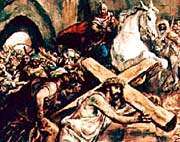 Some
critics charge that the Gospels have obscured the historical Jesus of Nazareth
by cloaking Him in layers of legend and myth.[1] They claim that the Bible's
stories of Christ's resurrection are myth, not history. There are at least FOUR
REASONS why the mythological interpretation fails.
Some
critics charge that the Gospels have obscured the historical Jesus of Nazareth
by cloaking Him in layers of legend and myth.[1] They claim that the Bible's
stories of Christ's resurrection are myth, not history. There are at least FOUR
REASONS why the mythological interpretation fails.
Historical research
is on the side of an immediate belief in Jesus' resurrection. An early apostle's
creed includes the Resurrection (1 Corinthians 15:3-9) and has been dated by
many scholars to within 3 to 7 years of Christ's death and resurrection.[3] This
implies prior public belief. Scholars agree that the first letters by St. Paul
appeared within 25 years or less of Jesus ministry, and the four Gospels within
21 (and no later than 65 years).[4] The preaching of the apostles always
centered on the Resurrection. In a very short period of time, devout Jews
throughout the Roman Empire who had formerly faithfully worshiped God on the
seventh day of each week, converted to Christianity and began meeting on the
first day, in celebration of Christ's resurrection.
Hundreds of
witnesses saw Christ alive after his death. Once he appeared to 500 people at
once (1 Corinthians 15:6).
REFERENCES
AND FOOTNOTES
John
Macquarrie writes, "Myth is usually characterized by a remoteness in
time and space... as having taken place long ago." By contrast the
Gospels concern "an event that had a particularly definite location in
Palestine... under Pontius Pilate, only a generation or so before the New
Testament account of these happenings." [John Macquarrie, God-Talk:
An Examination of the Language and Logic of Theology (Harper, 1967), pp.
177-180.]
A.N.
Sherwin-White writes, "The agnostic type of form-criticism would be much
more credible if the compilation of the Gospels were much later in time... than
can be the case... Herodotus enables us to test the tempo of myth-making, [showing
that] even two generations are too short a span to allow the mythical
tendency to prevail over the hard historic core." [A.N. Sherwin-White, Roman
Society and Roman Law in the New Testament (Oxford University Press, 1963),
pp. 189-190.] [up]
Is it true that the Bible's accounts of Christ's resurrection are full of contradictions?
The Gospels admittedly take a little effort to reconcile. But this
"problem," as it is typically framed, is vastly overstated.
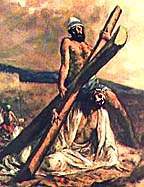 It
is commonly held that, since the Gospels differ from one another in emphases and
detail, there must have been invention somewhere. Yet such an interpretation is
not required! Reporters to any event (secular or religious), following all
standards of accuracy and integrity, will each edit their stories differently
with their eyes on what is relevant to their readers. Therefore, the rigid
demands of the hyper critics that all four Gospels be exactly alike are
arbitrary and artificial. Dr. Sayers states:
It
is commonly held that, since the Gospels differ from one another in emphases and
detail, there must have been invention somewhere. Yet such an interpretation is
not required! Reporters to any event (secular or religious), following all
standards of accuracy and integrity, will each edit their stories differently
with their eyes on what is relevant to their readers. Therefore, the rigid
demands of the hyper critics that all four Gospels be exactly alike are
arbitrary and artificial. Dr. Sayers states:
"One
is often surprised to find how many apparent contradictions [in
the Gospel Resurrection accounts] turn out not to be contradictory at all,
but merely supplementary... Divergences appear very great on first sight... But
the fact remains that all of [the Resurrection accounts], without
exception, can be made to fall into a place in a single orderly and coherent
narrative, without the smallest contradiction or difficulty and without any
suppression, invention, or manipulation, beyond a trifling effort to imagine the
natural behavior of a bunch of startled people running about in the dawn-light
between Jerusalem and the garden."[1]
REFERENCES
AND FOOTNOTES
"Miracles are not possible," some claim. Is this true?
|
|
Once God's existence is granted as a
possibility (and there is abundant evidence provided for it at this
site), miracles can't be dismissed out-of-hand. Rather, whether or not a
given miracle has occurred becomes a historical matter that calls for
investigation.[1] REFERENCES
AND FOOTNOTES
|
Was Jesus Christ's body stolen from his tomb?
There is no question that Jesus Christ's tomb was mysteriously empty. As
Paul Althaus has said, the resurrection message "could not have been
maintained in Jerusalem for a single day, for a single hour, if the emptiness of
the tomb had not been established as a fact..."[1] Dr. Craig observed
that, "Conflicting traditions [to the empty tomb story] nowhere
appear, even in Jewish polemic."[2]
At least one skeptic (Dr. John Dominic
Crossan) has wrongly asserted that Roman law automatically forbade Jesus'
burial, and that he must therefore have been thrown anonymously into a common
pit. This is not sustainable. Raymond Brown has shown that Roman burial policy
varied with circumstances and did allow the possibility of personal burial of
some of the crucified.[3] This scenario would also contradict the consistent
Jewish protests that the body had been removed.[4] Furthermore, the Gospels
could not have successfully invented as owner of the tomb one so specific as a
member of the Jewish Sanhedrin named Joseph of Arimathea (Mark 15:43). Had the
Gospels been false on this matter they would not have been able to withstand the
swift correction and ridicule from the Jews.
How have doubters of Christ's resurrection
responded? Some skeptics have claimed that someone must have stolen Jesus' body
from the tomb, and that this led to the stories of miraculous resurrection. Is
this possible?
THE JEWS
AND THE ROMANS
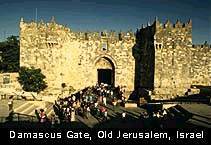 Neither
the Jewish nor the Roman leaders, who guarded the tomb (Matthew 27:62f) would
have taken the body. Rather, both had every motive to produce the body publicly
in order to humiliate the disciples and nip their movement in the bud. And since
the scene in question was right at Jerusalem, it was completely within their
power to locate the corpse should it still have existed. Yet to their dismay, no
such body was ever produced. If the Jews had the body, they would have wheeled
it in at the day of Pentecost when all Jerusalem was in an uproar because of
Peter's sermon on the Resurrection of Christ.
Neither
the Jewish nor the Roman leaders, who guarded the tomb (Matthew 27:62f) would
have taken the body. Rather, both had every motive to produce the body publicly
in order to humiliate the disciples and nip their movement in the bud. And since
the scene in question was right at Jerusalem, it was completely within their
power to locate the corpse should it still have existed. Yet to their dismay, no
such body was ever produced. If the Jews had the body, they would have wheeled
it in at the day of Pentecost when all Jerusalem was in an uproar because of
Peter's sermon on the Resurrection of Christ.
CHRIST'S
FOLLOWERS
Likewise, is highly unlikely that Jesus'
followers could have removed the body with a Roman guard protecting the tomb,
plus a large stone door. And it won't work to charge them with inventing the
account of the sleeping guards in Matthew. 28:11f. That story would only have
served as apologetic propaganda had the guards stayed awake.
Why would the disciples (or anyone else) want
to risk their lives to steal Christ's body? The biblical record shows the
disciples were scared, discouraged and disheartened. Their only motive could
have been to deceive. But everything we read about these men indicates they were
good and honest. How could they have gone out the rest of their lives and daily
preached that Christ had risen from the dead when they knew all along it was a
lie? Would they have sacrificed and suffered so greatly for something that they
know was an outright deception?
It would have been foolish to hide the corpse
and fake a resurrection. The consequences of their loyalty to Jesus included
beatings, imprisonments, and even death. No sane person chooses these for what
they know is false. Under such pressures, liars confess their deceptions and
betray their cohorts.
The explosive growth of the Church is strong
evidence for Jesus' resurrection. Significantly, it wasn't the powerful, but
commoners, burdened with every cultural strike against them (1 Corinthians
1:26f), whose Resurrection message peaceably transformed the Roman Empire. Who
would ever have predicted such an "impossible" feat? Yet it actually
did happen![5]
 That
Christianity originated in Judaism[6] is further evidence for his resurrection.
Renowned archaeologist William F. Albright observed, "In my opinion, every
book of the New Testament was written by a baptized Jew between the forties and
the eighties of the first century A.D."[7] Jewish bias against the Jesus of
the New Testament was massive. What else would have led Jews to accept a
shamefully hung (Galatians 3:13) "criminal", as their promised Messiah
when they had longed for a military deliverer? And what else would have moved
Jews to break their monotheistic convictions[8] to worship Jesus as God the Son
(John 1:18), or change their worship day from Saturday to Sunday (Acts 20:7)? A
mere invented myth would have been powerless to overthrow such hopes and
traditions.
That
Christianity originated in Judaism[6] is further evidence for his resurrection.
Renowned archaeologist William F. Albright observed, "In my opinion, every
book of the New Testament was written by a baptized Jew between the forties and
the eighties of the first century A.D."[7] Jewish bias against the Jesus of
the New Testament was massive. What else would have led Jews to accept a
shamefully hung (Galatians 3:13) "criminal", as their promised Messiah
when they had longed for a military deliverer? And what else would have moved
Jews to break their monotheistic convictions[8] to worship Jesus as God the Son
(John 1:18), or change their worship day from Saturday to Sunday (Acts 20:7)? A
mere invented myth would have been powerless to overthrow such hopes and
traditions.
"Jesus
was so unlike what all Jews expected the Son of David to be that His own
disciples found it almost impossible to connect the idea of the Messiah with
Him."[9]
-Millar Burrows
It is, as the New Testament
states, Jesus' resurrection that singly overcame that "impossibility"
(Acts 2:24).
CONVERSION
OF SAUL
In addition, the conversion of Saul of Tarsus
points to a momentous miracle. Beginning as a violent enemy of the Church (Acts
8:3; 9:1, Galatians 1:13), he was utterly turned around into becoming Jesus'
servant. Choosing suffering for Christ's sake (2 Corinthians 11:23f), Paul gave
up all he had, endured persecution, and preached the Gospel in city after city
all the way to Rome, where he died a martyr's death. He is credited with having
had greater influence over the course of the Roman Empire than any other figure
of the First Century apart from Christ.[10] Nothing short of Christ's
resurrection has remotely explained his major transformation.
THE OTHER
APOSTLES
The other Apostles too, overcame fear to
brave suffering, imprisonment, and even death, as they proclaimed the good news
of the risen Christ across their world. Is it thinkable that these people would
die so willingly for a mere myth? "Each of the disciples, except John, died
a martyr's death... because they tenaciously clung to their beliefs and
statements," observes researcher Josh McDowell.[11]
In contrast to others who have died for an
unverifiable hope beyond the grave (e.g., mystics seeking reincarnation or
Moslem militants expecting reward from Allah), Jesus' disciples lived and died
for the historically verifiable claim that the grave was empty and that he was
seen alive again.
Legal scholar Dr. Simon Greenleaf, founder of
the Harvard Law School, notes:
"Propagating
this new faith, even in the most inoffensive and peaceful manner,
[early Christians received] contempt, opposition... and cruel deaths. Yet
this faith they zealously did propagate, and all these miseries they endured
undismayed, nay rejoicing. As one after another was put to a miserable death,
the survivors only [continued] their work with increased vigor and
resolution... The annals of military warfare afford scarcely an example of like
heroic constancy, patience, and unblenching courage... If it were morally
possible for them to have been deceived in this matter, every human motive
operated to lead them to discover and avow their error. From these [considerations]
there is no escape but in the perfect conviction and admission that they were
good men, testifying to that which they had carefully observed...and well knew
to be true.[12]
Dr. Greenleaf is considered
by many to have been one of the greatest legal minds we have had in the U.S. He
was formerly an outspoken skeptic of Christianity and who set out to disprove
the deity of Christ. In the end he concluded that the Resurrection was true
"beyond any reasonable doubt." Greenleaf became a Christian after
studying the evidence for himself. Many top legal minds agree with Greenleaf
that if the case for Christ's death and resurrection were taken to a court of
law, it would undoubtedly win. The claims are very well established and verified
by independent and converging proofs.
REFERENCES AND
FOOTNOTES
Some claim that witnesses to Christ's resurrection must have been
hallucinating or experiencing mass hysteria, is this possible?
 On one point virtually
all scholars of every description agree, the first disciples were themselves
utterly convinced they had seen the risen Christ.[1]
On one point virtually
all scholars of every description agree, the first disciples were themselves
utterly convinced they had seen the risen Christ.[1]
The Christian gospel message about the death
and resurrection of Christ breathes through virtually every New Testament
document. So the real question is, how do we account for their obvious
conviction? Were they just hallucinating?
While perhaps at first sounding plausible,
many factors contradict such a notion.[2] To name a few:
"When this frightened
band of apostles suddenly could be changed overnight into a confident mission
society... Then no vision or hallucination is sufficient to explain such a
revolutionary transformation."[3]
Although Lipide is an Orthodox
Jewish rabbi who does not accept Jesus as the Messiah, he concedes the
inescapable evidence that Jesus must have risen from the dead.
REFERENCES
AND FOOTNOTES
What about the death and resurrection of Christ was important and vital to Christianity?
|
|
Many critics reject the "blood theology" of the Bible because
they see it as a remnant of a very barbaric type of primitive religion
termed a "slaughterhouse religion," Biblical Christianity is
abandoned by some who consider themselves too refined to include
thoughts of sacrifice in their worship. The Bible quite forthrightly states, "That
soul that sinneth, it shall die," and "the wages of sin
is death" (Ezekiel 18:20; Romans 6:23). In the moral government
of God, He has ordained that physical and eternal death be the just
penalty for sin. People may chafe against God's decree, thinking it is
unfair or extreme, but their protests only show how sin has blinded them
to sin's true nature. The fact that God requires such a drastic penalty
should teach them, not that God is brutal, but that sin is heinous. Yet God, in His matchless love for
sinful man, has also decreed that the penalty for sin can be born by a
substitute, and on that principle is built the Old Testament system for
sacrifice. "For
the life of the flesh is in the blood; and I have given it to you upon
the altar to make an atonement for your souls; for it is the blood that
maketh an atonement for the soul." Even if any man had
wanted to, he could not offer himself in payment for his sins, for his
sin had disqualified him from being an accceptable sacrifice.
Consequently, the Old Testament provided for the offering of certain
select animals whose blood was shed vicariously for the sins of those
who repented and trusted God's revelation. All of the spotless, innocent animals
that became sacrifices in the Old Testament pointed to that great
sacrifice, the one made by Jesus Christ on Calvary's cross. John the
Baptist introduced Him, saying "Behold the Lamb of God, which
taketh away the sin of the world" (John 1:29). The penalty God
imposed on sin is both just and loving, for God Himself, in the Person
of the Son, paid that penalty for all who will accept Him as their
Substitute. God the Son, clothed in human form,
shed His blood for man's sin, thus satisfying every demand of holy
justice. And through that precious blood, God showed Himself to be both "just
and justifier of him which believeth in Jesus" (Romans 3:26). The Bible portrays unsaved man as a
slave to sin and speaks of freeing him in the same manner as slaves were
redeemed in the ancient world. In Christ, "we have redemption
through His Blood, the forgiveness of sins, according to the riches of
His grace" (Ephesians 1:7). "You were not redeemed with
corruptible things, as silver and gold, from your vain manner of life
... but with the precious blood of Christ, as a Lamb without blemish and
without spot" (I Peter 1:18-19). Apart from Jesus Christ, all people
are alienated from God. Sin's rebellion forged a gulf between God and
man that is humanly impassable. Yet, Christ's blood built the bridge
from God to man. "Now
in Christ Jesus, you who formerly were far off have been brought near by
the blood of Christ." "But
God demonstrates His own love toward us, in that, while we were yet
sinners, Christ died for us. Much more then, having now been justified
by His blood, we shall be saved from the wrath of God through Him." Human sin produces
a pollution of the heart that can only be cleanses by God's grace. And
that grace manifests itself in the efficacy of Christ's sacrifice, the
Apostle John declaring, "the blood of Jesus Christ, God's Son,
cleanses from all sin" (I John 1:7). Revelation's glimpse of
the future glory gives this account: "These
are they which came out of the great tribulation, and have washed their
robes, and made them white in the blood of the Lamb. Therefore are they
before the throne of God, and serve Him day and night in His
temple." The Bible
emphasizes Christ's blood because only in His sacrifice can we find
forgiveness, cleansing, reconciliation, salvation, and glory!
Did
Christ really have to die before God could forgive sins?
At first glance, it seems that a God
who loves sinful men and women enough to save them could devise a
salvation plan that would not involve the death of His beloved Son. Is
God unreasonably vindictive in demanding that payment be made for sin?
Couldn't He forgive us without requiring some price to be paid? These questions probe the very nature
of God, and while we cannot fully understand God's infinite perfections,
the Bible reveals enough about His character to give us an answer (Job
11:7; Deuteronomy 29:29). While the Bible states "God is
love" (I John 4:8, 16), it does not present love as God's sole
attribute. Throughout Scripture God is portrayed as pre-eminently holy
(Psalm 99:9; Isaiah 5:16) - holy in character (Psalm 22:3; John 17:11),
holy in name (Isaiah 57:15; Luke 1:49), holy in works (Psalm 145:17),
holy in His kingdom (Psalm 47:8). The reason that Christians can count
on God's promises is because He has verified them with His holiness
(Psalm 89:35). The resolution of the alleged
conflict between God's love and His wrath lies only in His holiness. The
same God can show both love and wrath because He is first of all holy.
The angels surrounding God's throne sing neither "Love, love,
love" nor "Wrath, wrath, wrath," but rather, "Holy,
holy, holy" (Isaiah 6:3, Revelation 4:8). God's holiness involves a strict
separation from all sinfulness and perfect justice in dealing with the
sins of His creatures. If God were to violate this basic attribute, His
forgiveness would be well nigh useless. Of what value is the forgiveness
of someone who has no standards? The concept of salvation makes no sense
unless one starts with God's holiness. Consequently, sin is no trifle,
to be lightly dismissed or conveniently ignored. The existence of sin
necessitated some reponse. The Apostle Paul dealt with this
problem in Romans 3:21-26, and he shows how God could be both "just
and the justifier of the one who has faith in Jesus" (3:26). The
main emphasis of this passage is God's righteousness, mentioned in
verses 21, 22, 25 and 26. Since God's holiness remains an immutable part
of His character, He will not merely overlook sinful rebellion. However,
justice and mercy merge in God's plan for men, to provide the
"righteousness of God through faith in Jesus Christ for all those
that believe" (3:22). God does not have to violate His
holiness to provide salvation, for God the Son provides "a
propitiation in His blood" for those who believe (3:25).
"Propitiation" refers to the satisfaction of divine justice
and comes from the practice of anointing with sacrificial blood the
mercy seat on the Old Testament Ark of the Covenant. This application of
blood symbolized the death of a substitute as a penalty for breaking
God's law. Jesus Christ became our Substitute, "For the wages of
sin is death; but the (free) gift of God is eternal life through Jesus
Christ our Lord" (Romans 6:23).
Jesus suffered on the cross, and the
Apostle explains the suffering, saying, "This was to demonstrate
His righteousness; because of the forbearance of God He passed over sins
previously committed" (Romans 3:25). God had forgiven the sins of
the Old Testament believers on the basis of Christ's future sacrifice,
just as He forgives today on the basis of Christ's past sacrifice, done
once for all time (Hebrews 10:12). And in it all, God remains holy. The
crux of Paul's evangelistic teaching at Thessalonica was that
"Christ had to suffer and rise again from the dead" (Acts
17:3). Christ's death was not optional, for it was central to God's plan
of salvation. Some confusion results from the
erroneous notion that God the Father must not have loved Christ since He
required Him to die before granting forgiveness to sinful men and women.
This ignores the plain teaching of Scripture that Jesus was God the Son,
and, as equal in every perfection with God the Father, concurred in the
redemption plan. On the eve of His crucifixion, Jesus prayed,
"Father, the hour has come, glorify Thy Son, that the Son may
glorify Thee" (John 17:1). Hebrews 12:2 reveals that Jesus both
endured the cross and despised its shame because of "the joy set
before Him." While some modern errorists present Christ going to
the cross under protest against the cruel Father, the Scripture shows
the Father and Son in perfect harmony throughout redemption.
God's holiness, righteousness and
justice are immutable parts of His character, so He exercises judgment
on sin as One who is sovereign in His moral kingdom. Yet, He himself has
fulfilled that righteous penalty in the person of His Son so that,
without violating His holy nature, He guarantees forgiveness and
justification to all who believe. Authors: Henry Morris and Martin
Clark as excerpted from The Bible Has the Answer, published by
Master Books, 1987. Used with permission. "Easter
is not primarily a comfort, but a challenge,"
wrote J.N.D. Anderson, late Dean of the School of Law at the University
of London. "If it is true [as he and others indeed
demonstrate], then it is the supreme fact of history, and to fail to
adjust one's life to its implications means irreparable loss."[1]
The resurrection of Jesus Christ is
not about a mere historical curiosity, but an event of enormous
consequences to you. According to Romans 1:4, Jesus' resurrection
affirms the Bible's high claims about Him, and that He alone is the way
to heaven. Jesus said to him, "I am the way, the truth, and the life. No one
comes to the Father except through Me." Christ's
resurrection guarantees there will be a Last Judgment (Acts 17:31), and
that there is a heaven and a hell (Revelation 1:18). Yet this Risen Christ offers the
forgiveness of sins and everlasting salvation for whoever believes in
Him (John 11:25,6, Romans 4:24,25). Everyone is inescapably affected by
these implications. YOUR
DECISION? A NEW BEGINNING? Therefore you can't afford to remain
an agnostic regarding Jesus and His claim on you. While many today are
indifferent to such matters, avoiding Him is not an honest proposition.
The mounting evidence supporting His claims demands your consideration! And consideration is demanded not
only for your intellect, but for your whole being! For the One who is
"Alive forevermore" (Revelation 1:18) says, "Behold,
I stand at the door and knock; if anyone hears my voice and opens the
door, I will come in and eat with him and he with me." By "door"
is meant access to your heart, mind, and will. Jesus desires entry into
your life that He may be your Savior and Lord. So "Today...Do not
harden your heart" (Hebrews 4:7). Rather, open your heart to Him,
and let the One who died and rose for you come in! REFERENCES AND FOOTNOTES
|
Where did Jesus get his name? (Jesus)
Meaning: Salvation, or "the Lord is
salvation," "the Lord Saves."
"Jesus" is the Greek form of the
Hebrew name Joshua which was originally Hoshea (Oshea) (Num. 13:8, 16 - the King
James Version of the Bible spells it "Oshea"), but changed by Moses
into Jehoshua (Num. 13:16; 1 Chr. 7:27), or Joshua. After the Exile it assumed
the form Jeshua, from which came the Greek form Jesus. It was given to our Lord
to denote the object of his mission, to save. An angel told Joseph (his
foster-father), "You are to name him Jesus, for he will save his people
from their sins" (Matt. 1:21).
JESUS CHRIST - Je'sus, the proper, as Christ
is the official, name of our Lord. To distinguish him from others with the same
name, he is spoken of as "Jesus of Nazareth" (John 18:7), and
"Jesus the son of Joseph" (John 6:42).
The life of Jesus on earth may be divided
into two great periods, (1) his private life, till he was about thirty years of
age; and (2) his public life, which lasted about three years.
In the "fulness of time" he was
born at Bethlehem, in the reign of the emperor Augustus, of Mary, who was
betrothed to Joseph, a carpenter (Matt. 1:1; Luke 3:23; compare John 7:42). His
birth was announced to shepherds (Luke 2:8-20). Wise men from the east came to
Bethlehem to see him who was born "King of the Jews," bringing gifts
with them (Matt. 2:1-12). Herod's cruel jealousy led to Joseph's flight into
Egypt with Mary and the infant Jesus, where they waited till the death of this
king (Matt. 2:13-23), when they returned and settled in Nazareth, in Lower
Galilee (2:23; compare Luke 4:16; John 1:46, etc.). At the age of twelve years
he went up to Jerusalem to the Passover with his parents. There, in the temple,
"in the midst of the doctors," all that heard him were
"astonished at his understanding and answers" (Luke 2:41, etc.).
Eighteen years pass during which we have no
record, except that he returned to Nazareth and "increased in wisdom and
stature, and in favor with God and man" (Luke 2:52).
He entered his public ministry when he was
about thirty years of age. It is generally believed to have lasted about three
years. Each of these years had particular features of its own.
|
|
|
THE YEARS OF JESUS CHRIST'S MINISTRY
1.
The first year may be called the year of obscurity, both because the
records of it which we possess are very scanty, and because he seems during it
to have been only slowly emerging into public notice. It was spent for the most
part in Judea.
2.
The second year was the year of public favor, during which the country
had become thoroughly aware of him; his activity was constant, and his
reputation was known through the length and breadth of the land. It was almost
wholly passed in Galilee.
3.
The third was the year of opposition, when the public favor ebbed away.
His enemies multiplied and assailed him with more and more persistence, and at
last he fell victim to their hatred. The first six months of this final year
were passed in Galilee, and the last six in other parts of the land"
(Stalker's Life of Jesus Christ, p. 45).
The Gospels are
eyewitnesses accounts of the words and work of Jesus Christ in many different
aspects.
Jesus was also the name of four other men
in the Bible...
1.
Joshua, the son of Nun (the King James Version says "Jesus" in
Acts 7:45 and Heb. 4:8; all new translations avoid confusion by using the name
"Joshua")
2.
A Jewish Christian surnamed Justus (Col. 4:11)
3.
Jesus Barabbas (sometimes just called Barabbas) - prisoner
released by Pontius Pilate (Matt. 27:16-17)
4.
An ancestor of Christ (Luke 3:29). Translated as Jose in the King
James Version and NJKV, Joshua in the NIV and NASB.
What does the name "Christ" mean?
Meaning: anointed, the Greek translation of
the Hebrew word translated "Messiah"
Christ is the official title of our Lord,
occurring 1,514 in the New Testament. It denotes that he was anointed or
consecrated to his great redemptive work as Prophet, Priest, and King of his
people. He is Jesus the Christ (Acts 17:3; 18:5; Matt. 22:42), the Anointed One.
He is thus spoken of by Isaiah (61:1), and by Daniel (9:24-26), who describes
him as "Messiah the Prince."
The Messiah is the same person as "the
seed of the woman" (Gen. 3:15), "the seed of Abraham" (Gen.
22:18), the "Prophet like unto Moses" (Deut. 18:15), "the priest
after the order of Melchizedek" (Ps. 110:4), "the rod out of the stem
of Jesse" (Isa. 11:1, 10), the "Immanuel," the virgin's son (Isa.
7:14), "the branch of Jehovah" (Isa. 4:2), and "the messenger of
the covenant" (Mal. 3:1).
This is he "of whom Moses in the law and
the prophets did write." The Old Testament Scripture is full of prophetic
declarations regarding the Great Deliverer and the work he was to accomplish.
Jesus the Christ is Jesus the Great Deliverer, the Anointed One, the Savior of
men. This name denotes that Jesus was divinely appointed, commissioned, and
accredited as the Savior of men (Heb. 5:4; Isa. 11:2-4; 49:6; John 5:37; Acts
2:22).
To believe that "Jesus is the
Christ" is to believe that he is the Anointed, the Messiah of the prophets,
the Savior sent of God, that he was, in a word, what he claimed to be. This is
to believe the gospel, by the faith of which alone men can be brought unto God.
That Jesus is the Christ is the testimony of God, and the faith of this
constitutes a Christian (1 Cor. 12:3; 1 John 5:1).